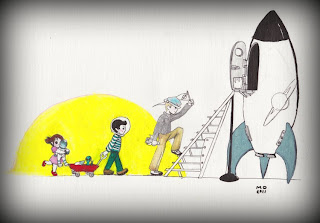It's probably my own fault. But whenever I come to London, I can't help feeling all around me the reproach of the past: in my case, the eye-rolling, tut-tutting disapproval of dead literary Londoners.
Take a Street called Gloucester Place on the fringe of London's West End. It's not much to look at, just two rows of tall, early-nineteenth-century buildings staring out at each other over a constantly flowing river of traffic.
But within a few minutes' walk at Number 27, there's enough literary celebrity to keep anyone who follows the scribe's trade, as I do, depressed and awake nights.
For example, within spitting distance-and that's how I sometimes feel-there's the house where Elizabeth Barrett wrote the book of poems that made her the toast of London and the wife of Robert Browning. There's the house where Wilkie Collins invented the crime novel by writing The Moonstone; and a little farther on, another, where his friend Charles Dickens sat at his desk churning out little items like The Old Curiosity Shop and David Copperfield.
Around the corner on Montagu Square, there's the house of Anthony Trollope, who had the gall to do no more than three hours' work a day while producing novels like The Warden and Barchester Towers.
Worst of all, perhaps, there's the doctor who was Trollope's near-neighbor on Montagu Place. This doctor had a practice a few minutes' walk away, but his heart wasn't in it. He arrived at his consulting rooms, he later wrote, "at 10 and sat there until 3 or 4 with never a ring to disturb my serenity."
So what did he do? Was he content with his leisure? No, no, not a bit of it. To while away the time and fill the unforgiving minutes, he resuscitated a certain hero he'd created a few years before while living in Portsmouth, and whose exploits now began to appear regularly in The Strand magazine. In doing so, the good doctor launched upon this area (and upon the world) a ghost so real that it has haunted this part of London ever since, though it can never be exorcised because it never existed.
This ghost is "the grandson of a sister of the French artist Vernet." He is 6 feet tall, with a narrow face, thin lips, gray eyes, and a quick, high, strident laugh. His name is Sherlock Holmes.
Holmes' ghost, as raised by Sir Arthur Conan Doyle, can be found, if you're foolish enough to look for it, all over London. But its special hunting ground is Baker Street, where he lodged, as everyone who's ever heard of Dr. Watson or Professor Moriarty knows, at Number 221B.
Now 221B-and you have to remember this-never existed; modern Baker Street, in any case, has almost nothing in common with its nineteenth-century forerunner-it's filled today with shops and pizza joints and anonymous postwar buildings.
Still, it's virtually impossible to escape the way its most famous nineteenth-century nonresident has stamped his mark on it. You can't buy a newspaper on Baker Street without running into the silhouette of a man with a curly pipe and a deerstalker, plastered on the glass front of a chemist's shop. There's even a Sherlock Holmes Hotel at Number 108, where Dr. Watson's Bar offers a Mrs. Hudson's Tea (sandwiches, scones, muffins, and crumpets) in the afternoon, and such items as The Hound of the Baskervilles for most of the rest of the day. (The Hound of the Baskervilles is-wait for it-a jumbo hot dog.)
But this is only the beginning of the Holmes mania. I saw what can only be described as a gaggle of fans on one of the quieter reaches of what used to be called Upper Baker Street. They were excitedly photographing each other against the walls of a nearby building society. The building society in question was erected, by the look of it, in the 1930s, and I wondered what on earth they were doing. I asked one of the fans whether he was there on pilgrimage or what. There was a moment of incomprehension…
Now I know a challenge when I see one. So within two shakes of a hound's tail I was on this (totally fictional) trail.
In 1930, number 221 was created by the incorporation of Upper Baker Street into Baker Street itself. The building so honored was, however, soon demolished, and in 1932, odd numbers 215 to 229 were assigned to the new Abbey House, headquarters of the Abbey Road Building Society (later the Abbey National, now simply Abbey). Letters to Sherlock Holmes poured in from all over the world, in such numbers that Abbey House decided to appoint a secretary to Sherlock Holmes.
All was well until 1990, when the Sherlock Holmes Museum opened just down the road at number 239. Determined to lay claim to Sherlock Holmes' address, the museum gained the right to put the appropriate number on the door by the expedient of registering a company by the name of 221B Ltd.
 But Abbey House was not ready to relinquish its role as guardian of the great man’s memory without a fight. Matters came to a head in 1994, when the Sherlock Holmes Museum failed in its attempt to be officially designated number 221B Baker Street.
But Abbey House was not ready to relinquish its role as guardian of the great man’s memory without a fight. Matters came to a head in 1994, when the Sherlock Holmes Museum failed in its attempt to be officially designated number 221B Baker Street.
And the building society was not doing a bad job in honouring the illustrious detective, even commissioning in 1999 the bronze statue which now stands outside Baker Street Tube Station.
But when Abbey moved on in 2002, the wrangling ended. Since then, no one, except true blue fans, has been in any doubt that the Sherlock Holmes Museum occupies the Sherlock Holmes address.
Have you any idea how serious this Holmes business is? There are well over a thousand Sherlock Holmes societies (usually called Baker Street Irregulars) worldwide, including 156 in the United States alone. (Members there name themselves after characters in the stories, like Brother McMurdo, Bodymaster McGinty, and Brother Ted Baldwin. I kid you not.)
 This was too much. A museum to a nonexistent person! And at the wrong number! (By this time, I had rooted through a few books and spoken to quite a few local fans, and had found that Baker Street had been renumbered twice since Holmes' unday, leaving the best candidates for Mrs. Hudson's unlodging house at Numbers 60, 109, or 111.) Still, it was, of course, an opportunity too good either to be true. So I ventured ahead, and under a blue plaque announcing SHERLOCK HOLMES, CONSULTANT DETECTIVE, I stepped into his lodgings.
This was too much. A museum to a nonexistent person! And at the wrong number! (By this time, I had rooted through a few books and spoken to quite a few local fans, and had found that Baker Street had been renumbered twice since Holmes' unday, leaving the best candidates for Mrs. Hudson's unlodging house at Numbers 60, 109, or 111.) Still, it was, of course, an opportunity too good either to be true. So I ventured ahead, and under a blue plaque announcing SHERLOCK HOLMES, CONSULTANT DETECTIVE, I stepped into his lodgings.
According to local folklore, Aidiniantz, its creator, had walked up Baker Street one day, counting the numbers of the houses from where they started on the corner of Oxford Street. And when he arrived at what should have been, by this logic, 221B, he'd found, not the building society, but Number 239, a modest house built in 1815. It had been lying empty since 1934; had been until then a lodging house (like Mrs. Hudson's); and was now (amazingly) available for sale, complete with what remained of its Victorian fittings. Aidiniantz claimed that he had first to see whether the house matched the stories. Did it, for example, have exactly seventeen steps up from the street, as mentioned in 'A Scandal in Bohemia'? It did. Did it have two large windows in the sitting room, and could Mr. Holmes have got to them in a single bound from his bedroom, as he did in 'The Mazarin Stone'? He could.
Further research revealed that a Dr. Watson had lived next door though he had been a manufacturer of artificial teeth. Also, some of the maids who worked in this house were said to be relatives of a Mr. Holmes, who may or may not be the same one who, I found, did buy a villa in Sussex about 1904.
At this point I tried to remind myself that Sherlock Holmes was a fictional character, for God's sake.
But all the fans visiting seemed to be unfazed by this fact. "Look," they say happily, "We’re not saying that Mr. Holmes lived here; and we’re not saying he didn't."
In the face of such blithe good nature, what could I do but surrender? So I meekly did a tour of the museum: through Holmes' impedimenta, his pipes and tobacco slipper, his desk, his chemistry set and violin; through Mrs. Hudson's sitting room and Dr. Watson's room.
But then a fan showed me a photograph of Sherlock and said: ''This is the prize of my collection. It was sent to me by someone in Scotland, and it's believed to be the only existing photograph of Mr. Holmes, probably taken when he was a student. . . ."
I fled. I mean, its one thing to have to compete with dead writers in this area, but quite another to have to cope with a fictional creation who has a museum and is still alive at about 160 years of age.
Still, I mused: Conan Doyle, while penning A Study in Scarlet, really did write 221B Upper Baker Street, and then crossed out the "Upper." Did he do it to cover both his and Holmes' tracks? Hmmm, I thought, I should investigate. Then, my eye caught a shop sign: WHERE'S WATSON? Where indeed!!











































